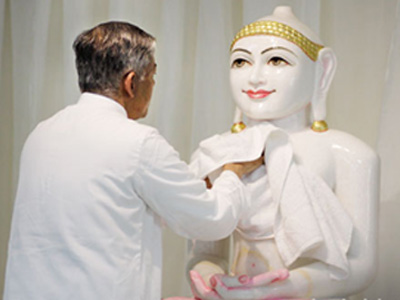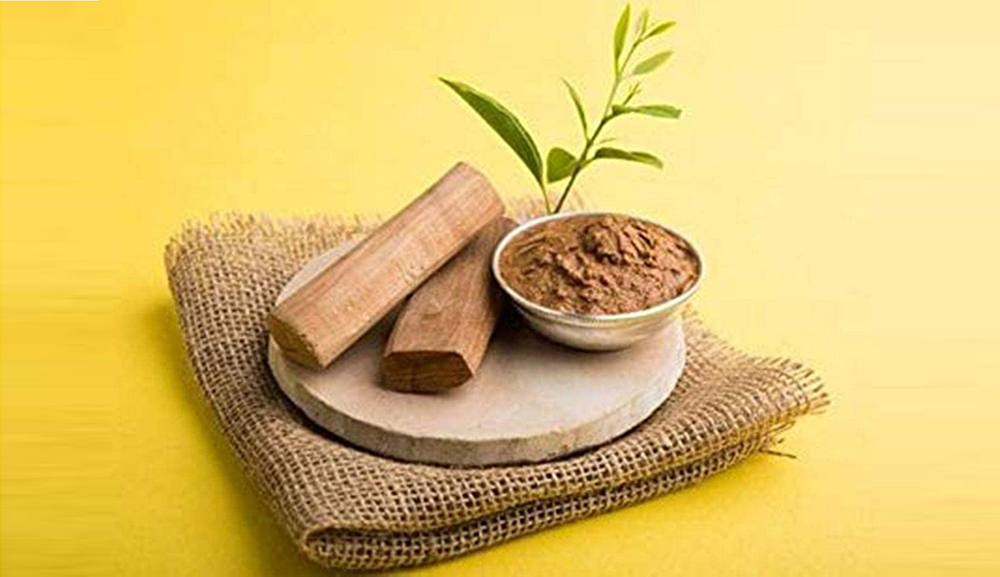Imagine waking up on a breezy and dusky morning. The sun is just peaking beyond the horizon as you make your way through Simandhar City to reach the beautiful Trimandir. While walking, you hear the serene sounds of "Simandhar Swami Na Aseem Jai Jaikar Ho" emanating from the mandir. You feel fresh, you feel pure, and you feel alive as you slowly climb the mandir steps until right in front of you, is the divine and gorgeous Simandhar Swami. Everyone is just beginning to recite the Charan Vidhi, loudly and with utter devotion, while you get prepared to do Simandhar Swami's Prakshal. Swami is there, you are there, and there's nothing else but purity all around you. As you complete Prakshal and bow down to Swami, you ask for nothing but MOKSHA. Now, what is the value and importance behind everything that you just did? Well, let's take a look!

Starting 5:00 A.M., the Trimandir's pujaris (priests) start to prepare the materials necessary for Prakshal (i.e. undress the murtis, place water, gather the chandan, flowers, etc). Depending on the days, men and women alternate doing Prakshal for Simandhar Swami and the other Tirthankar idols. The Prakshal starts at 6:00 A.M., and the schedule is:
Bhaio (Men) – TUE, THURS, SAT, SUN
Beno (Women) – MON, WED, FRI
The Step-by-Step Process
Since the bhaio and beno take turns for Prakshal, if it’s the bhaios turn, the beno first (5 minutes) get a chance to simply bathe and bow down to Swami to take blessings. Once they are done and come out of Swami’s shrine, then the bhaio will proceed in performing the full Prakshal (vice versa). Let’s take a deeper look into the exact steps of Prakshal, as if you are performing it:
Scenario: Suppose you come into the Trimandir at 5:45 A.M. Since you have 15 mins before Prakshal, you take that time to do darshan (prayers) to all the Bhagwans/Dev/ Devis. It is now 6 A.M. and you are ready for Prakshal. Before entering Swami’s shrine, you wrap a handkerchief/cloth/scarf/something around your face covering your nose and mouth only. The significance of this act is such that no organisms (even in the air) are killed by our hot breath near the precious idols. It also prevents any germs from going on the idol from our nose/mouth. Now, you bow down to Swami’s shrine and then enter. Start these steps:
1) Take a loto (steel pot) that will be placed on the sides/stairs, and fill it with water.
2) Slowly pour the water from the spout on the murti, washing off any chandan from the day before.

Chandan is sandalwood paste that is an integral part of many rituals and ceremonies. The paste is prepared by the pujaris by grinding wood by hand upon granite slabs; with slowly adding water (sometimes mixed with saffron), a thick paste results. Chandan has a sweet fragrance and beautiful color!
3) At this point, you will notice all Mahatmas washing the murti all around. Depending on what 'part' you're playing, you just have to go with the flow. One sevarthi is designated to climb the ladder in front of Swami, and one climbs in the back. The rest stay on the floor of the shrine (either in front or on top of the steps). Depending on what is needed, you will see them pick positions. They all work together this way and help one another.
4) Once all the chandan is washed off Swami, there will be clean white cloths that are used to wipe the whole murti. Depending on where you're positioned, wipe the murti spotless. There shouldn't be any water droplets, and even in the nooks and cranny of the murti, water should be wiped. If you are unsure how to wipe inside the nooks, a sevarthi will gladly show you as there are tools used. For example, in the middle of Swami's hands, the white cloth is placed over a long rod that can go inside the tiny spaces and wipe them.
5) Along with wiping the murti, the floor of Swami's shrine will be covered with a lot of water that needs to be filtered out. Using wipers pull/push all the water towards the drains. Make sure no water is left on the floor as someone can slip over.
6) After most of the water is drained out, use the floor cloths to manually wipe the floor. This way, any spots missed will be thoroughly wiped. You will notice some sevarthis wiping the top floor, and some wiping the bottom floor. Make sure ALL the steps are thoroughly wiped since many people climb those steps daily.
7) Now that everything is clean, Simandhar Swami will now be dressed. On both his arms, there will be colorful cloth garments to be tied. Make sure the correct one is on the correct arm. At the same time, the sevarthis on the ladders will be putting Swami’s cloth haar (garland) on him. You’ll see the others on the floor helping them position the huge garland by taking to them. Also, a beautiful cloth neckpiece is also placed around Swami’s neck. Once Swami is dressed, the sevarthis will slowly take a rose garland to place on Swami and will position it according to the cloth garland (tied outside Swami's ears). They do this slowly so that not too many petals fall off. During this entire process, it is critical that no garments or garlands touch the floor.
8) Now it's time for Seva Puja (Chandan Ritual)! Following these exact steps, Seva Puja will be done to Swami. You will see 2 containers with chandan inside. This is how the puja is completed. Using the right hand's ring finger, dipped in the chandan, scooping some on the finger. It is then placed, in a large circular motion, on the idol on various positions.
9) You just did Simandhar Swami's Seva Puja! Now, you will have to put Swami's gold gear (Ears and Centerpiece) on. Be careful as they can be quite heavy and must climb on a ladder to do so.
10) Now, how AMAZING was that experience? This was Swami's Prakshal, you can also experience other Tirthankar's Prakshals on other days:
a. Rishabhdev Bhagwan
b. Ajitnath Bhagwan
c. Parshwanath Bhagwan
d. Mahavir Bhagwan
e. Padmanabha Prabhu
Significance and Value behind Prakshal
Gnanis explain that, “after locating a living Tirthankar, if you cultivate devotion for Him through worship, you will eventually experience pratyaksh darshan (live spiritual vision), and thereafter attain Keval Gnan and Moksha. However, you may be thinking that Prakshal is so early! Well, the time between 4:30 A.M. and 6:30 A.M. is the most auspicious time to do darshan and vidhis because this is the natural time when the influence of Satyug (Time cycle of purity and unity in thoughts, speech and actions) predominates, even in this current worldly stage of Kaliyug (Current era of the time cycle characterized by lack of unity in thought, speech and acts)! At this time, Swami is completely hajar (present here). By praying with the utmost sincerity and simplicity for shakti (strength) to continue towards spiritual progress and attain Moksha, Swami will be able to 'see' this in His vision. This is why it is so valuable to be in the Trimandir, in front of Swami, and doing his very own Prakshal! It's an amazing experience to start your day in front of the Living Tirthankara; you will feel such peace and happiness from within.”
“Those Who Receive This Gnan Will Only Have One Or Two More Lives. They Must Go To Simandhar Swami And Do His Darshan. That Is All That Remains For Them. His Very Darshan Gives Moksha. This Darshan Is The Highest Of All. Once This Darshan Is Done, Moksha Occurs!”